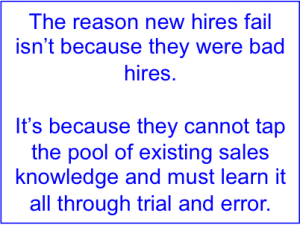Executives don’t want to be summarized. They want to be briefed, which is what your executive summary needs to do. While common terminology is “executive summary,” approaching it as an executive briefing will put you in the proper persuasive mindset.
It all tracks back to Dr. Tom Sant. Know him? If you prepare proposals or briefings to make your sales living, then Dr. Sant’s subject matter expertise needs to be in your toolbox.
He’s written a few books, one of which is Persuasive Business Proposals. I highly recommend it, and not just because I used to work with Dr. Sant at one of the companies he founded. Its value is in how he ties proposal writing to the psychology of how humans make decisions. It’s a master class in how to use persuasive language in sales when building proposals and their executive summaries.
For the sake of this article—and to help keep us focused on the executive summary—I want to focus on one of Dr. Sant’s most helpful guidelines, which goes by the acronym NOSE.
- Needs: Spell out your understanding of the prospect’s problems.
- Outcomes: Confirm the results they anticipate when their problems are solved.
- Solution: Recommend how you can solve the problem.
- Evidence: Illustrate how you’ve solved similar problems in the past and who else trusts you to solve such problems.
According to Dr. Sant, by organizing your executive summary to align with NOSE, you’ll address three questions that executives want answered while being briefed:
- Are we getting what we need?
- Is it really worth the investment of resources and time?
- Can they really deliver?
Many salespeople make the mistake of focusing more on “summary” than “executive.” Summaries tend to not provide answers. They’re more like glorified tables of contents for the larger proposal.
Create the executive summary with the understanding that it’s likely the only part of a proposal that executive-level decision-makers will review. You have to elicit the desired response from a proposal without including everything that goes into a proposal. No doubt it’s a top-flight challenge in persuasion, but it’s the hurdle your executive summary has to leap.
Executives want to see that you understand their needs and desired outcomes, their pains and wants. Seeing this level of understanding articulated in the executive summary helps relieve any anxiety they may have as check writers. Many executives just want the briefing to overcome their fear of making the wrong decision or selecting the wrong vendor, which can be a career-damaging move.
5 more tips for writing an executive summary that packs a punch
There are heaps of tips written in-line in the template. It’s a template with instructions, like one of those fresh dinner boxes you can have delivered that has all the groceries and the recipe you need to make a meal, but without all the surprise prep work that no one ever mentions (“Wait, I still have to marinate this meat and chop all these veggies?”).
In fact, there’s so many tips that I didn’t have room for these four, so I’m dropping them in here:
- Create a title using a dynamic verb: Sadly, the most popular title for an executive summary is “Proposal for Prospect Company.” Use the title as an opportunity to capture the executive’s attention. “Increasing lead-generation…,” or “Visualizing revenue forecasting…,” or “Streamlining cloud storage…” or whatever it is that your solution is going to do for them.
- Use the recipient’s actual name whenever possible: It makes recipients feel important and personally attended to when they see their name on the front page.
- Aim for a 3:1 ratio of recipient company name versus your company name: Make the document feel customized to them, not you.
- Show how well you understand your prospect’s needs: Sales or business development representatives should provide this information either from experience or from a formal discovery phase that needs to happen prior to your building a proposal with an executive summary. List only 3-5. Six and beyond are dismissed by the brain as trivia, and are almost never read.
- Make sure your key functionalities match your prospects’s desired business outcomes: If they don’t, it’s probably not a good fit.
Executive summary template: Use it or reference it, whichever works best for you
I could tell you *how* to write an executive summary until the cows come home. But, if you’re anything like me, things don’t really click until you see these best practices put into action.
That’s why I pulled together an executive summary template based on Dr. Sant’s NOSE. Replace the in-line instructions with recommended content and you’ll end up with an executive summary that’s bound to impress. Or, at the very least, that’s bound to address executive-level strategic concerns about your proposal. Download the full template here.
Pro-Tip: When you’re ready to write your own executive summary, make a copy of the template. Then, delete all the comments. That way you don’t accidentally fire off a document complete with my tips and tricks.
Business & Finance Articles on Business 2 Community
(59)
Report Post






